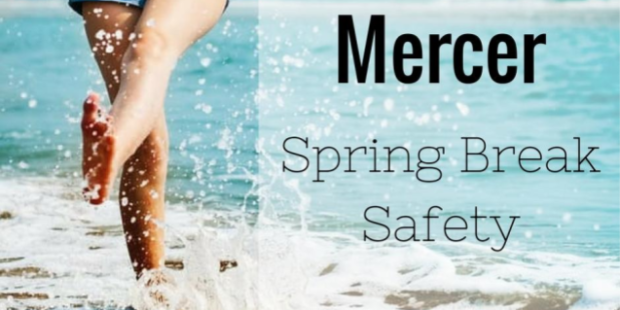
Today we continue our monthly personal safety column penned by Michael Mercer of Michael Mercer Consulting. This retired police officer is now a crime prevention consultant with over 30 years of experience preventing crimes against people, businesses, and properties. His offering includes prevention consulting, instructional classes, and educational programs. Mercer is a certified SABRE Personal Safety Academy Instructor.
Spring, for many of us, it is a time of transitioning from the cold weather to warmer days and nights. For others it is a time to stop and take a breath from the grind of school with some necessary time to relax. For millions of young people, this means Spring Break – a rite of passage for college students – at the best destinations around the country and outside the U.S. The most popular places like Cancun Mexico, Nassau Bahamas, South Padre Island Texas, Daytona Beach Florida, Lake Havasu Arizona and others are descended upon by millions of American youth.
In this month’s Consulting Mercer, I will talk about the risks, prevention, and defense. Thank you to SABRE for the encouragement to write this article and acknowledging the dangers.
Plan well.
Planning your Spring Break with your family or a trusted adult is recommended. Book your trip with a reputable travel agent and request a hotel room on a higher floor. First floors are easy to break into and accessible to unwanted guests. When using your travel guide make sure you prepare for responsible transportation. When you plan ahead you prevent drinking and driving and secure a safe ride.
Use the buddy system.
Make sure you have your “partner in crime prevention.” Travel in groups and always let others know where you are going and when you will return. Leave home with your friends and never return without your friends, NEVER!
Trust your gut.
If something seems wrong, trust your feelings and leave. Don’t put yourself in risky situations. Never do anything you are uncomfortable doing. When you go out, don’t wear expensive jewelry, leave it at home.
Be prepared.
No matter how many precautions you take, something could still happen. Carry your pepper spray and attach a personal alarm to your purse or backpack. These can be purchased at www.michaelmercerconsulting.com.
Take care of yourself.
Excessive alcohol and the hot sun do not mix. Dehydration and a sunburn will ruin your Spring Break. While we are on the topic of alcohol, please note that forgetting moderation can result in health and safety risks.
Club drugs and predatory drugs are also addictive. People who use GHB (commonly referred to as a “club drug” or “date rape” drug) for example, report detoxification symptoms after they stop using; repeated use in spite of unpleasant occurrences while they were on the drug; and great difficulty in not using again. Similarly, users of Ecstasy experience withdrawal symptoms and a renewed craving for the drug after those symptoms have passed.
There is a lot of misinformation being circulated about club drugs, especially on the Internet. The truth is that club drugs are illegal, harmful substances, and using them with the belief they cannot hurt you makes them even more dangerous. The best thing that you can do is to make healthy, informed decisions about your life. Don’t give in to peer pressure.
Never leave your drink unattended.
Never leave a drink unattended. These drugs are typically slipped into an unsuspecting woman’s drink. If you go to the restroom or anywhere else, bring your drink with you. If you accidentally leave your drink alone while you walked, or even just turned, away, order another. The most common drug used before an assault is alcohol.
Final reminders.
Have fun but always stay aware of your surroundings. Keep your cell phone on you and charged, keep enough money for a ride, and always carry a personal defense product like SABRE pepper spray.
Recent developments in Mexico.
College students making plans for spring break travel may want to review a U.S. State Department advisory, warning of potentially dangerous places in Mexico.
The advisory was issued in November, but may take on new urgency following last weekend’s deadly attack by four gunmen at a club in the popular tourist destination of Cancun, where at least five people were killed and another five were wounded. The advisory is designed to give travelers a better understanding of places to avoid or take extra precautions. All 31 states in Mexico have warnings in place, with five states listed as “Do Not Travel,” the Houston Chronicle reported, citing the Mexico Travel Advisory.
“Exercise increased caution in Mexico due to crime. Some areas have increased risk,” the advisory said. “Violent crime, such as homicide, kidnapping, carjacking, and robbery, is widespread.”
The State Department used four travel advisory levels to categorize each area of Mexico: Level 1 means to exercise normal precautions, Level 2 means to exercise increased caution, Level 3 means to reconsider travel and Level 4 means do not travel. The states that are under the “Do Not Travel” list due to crime, include Colima, Guerrero, Michoacan, Sinaloa and Tamaulipas. “We want you to know the danger of traveling to high-risk places and to strongly consider not going to them at all. Traveling to high-risk locations puts your life, and possibly the lives of others, in jeopardy,” the state department said in their “High-Risk Area Travelers” page, adding that additional risks include hostage-taking and serious injury. (Fox News, 2019)
Here is the link to the US State Department Website: https://travel.state.gov/content/travel/en/international-travel/before-you-go/travelers-with-special-considerations/high-risk-travelers.html
 Michael Mercer Consulting, President
Michael Mercer Consulting, President
Bird’s Eye Technologies, Co-Founder/CEO
Maine Association of Police Retirees, President
International CPTED Association
Greater Portland Board of Realtors, Education Committee
MREMA Associate Member
International CPTED Association
www.michaelmercerconsulting.com
michael@michaelmercerconsulting.com
207-699-8840







